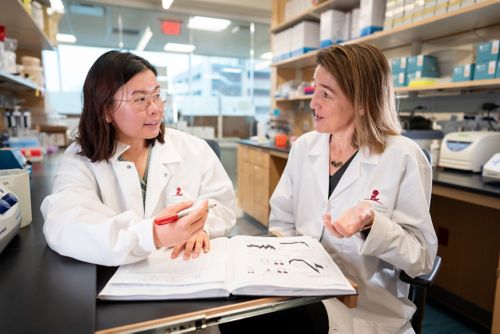St. Jude Family of Websites
Explore our cutting edge research, world-class patient care, career opportunities and more.
St. Jude Children's Research Hospital Home

- Fundraising
St. Jude Family of Websites
Explore our cutting edge research, world-class patient care, career opportunities and more.
St. Jude Children's Research Hospital Home

- Fundraising
Epigenetic insights help reveal the causes of unsolved epileptic neurological disorders
To effectively treat a disease or disorder, doctors must first know the root cause. Such is the case for developmental and epileptic encephalopathies (DEEs), whose root causes can be complex and heterogeneous. DEEs affect 1 in 590 children in the United States each year and involve more than 825 genes.
When a child is diagnosed with DEE, linking the encephalopathy to a specific gene can help facilitate appropriate treatment or symptom control. However, current testing methods can clinically identify the root cause, or etiology, of only 50% of individuals’ DEEs. Unfortunately, the remaining half of patients’ encephalopathy remains unexplained.
Addressing the genetic root causes for DEEs has been a long-term goal for Heather Mefford, MD, PhD, Pediatric Translational Neuroscience Initiative and Department of Cell & Molecular Biology. Mefford was instrumental in raising the number of diagnosable cases to 50%, up from approximately 5% just a decade ago.

Heather Mefford, MD, PhD, Department of Cell & Molecular Biology (right), and Christy LaFlamme, St. Jude Graduate School of Biomedical Sciences (left), used DNA methylation patterns to identify the causes of previously unexplained developmental and epileptic encephalopathies (DEEs), offering new hope for diagnosing rare cases.
Today, 80% of identifiable DEEs can be explained by 27 genes. To tackle the remaining unsolved cases, the numerous rare occurrences of these disorders must be identified, a challenge that Mefford and her team embrace. The team is exploring epigenetics, the changes in gene expression, as a potential solution. One such epigenetic change involves a process called DNA methylation. This process regulates gene expression by adding a methyl group to a gene’s promoter region, which prevents transcription factors from binding to the DNA, ultimately leading to gene silencing or reduced expression.
In a study published in Nature Communications, Mefford and her team demonstrated that DNA methylation patterns can help identify the cause of DEEs. Their findings highlight how specific gene and genome-wide methylation “epi-signatures” can help pinpoint genes responsible for the disorder.
“For some genetic disorders, everyone with a mutation in the same gene has a methylation profile across their genome that puts them in a category with all the others with the same genetic disorder,” said Mefford. This methylation landscape is called an “epi-signature” and is akin to a DEE fingerprint.
While epi-signatures allowed the researchers to broadly identify DEE-causing variants, taking a closer look at the individual methylation instances, referred to as rare differential methylation analyses, revealed further insights. “The underlying cause of the disease manifests in an epi-signature that can serve as a marker for that gene,” explained co-first author and Graduate School of Biomedical Sciences student Christy LaFlamme. “With rare methylation events, their analysis can point directly to the cause of the disease.”
Exploring these rare methylation events across the genome using long-read DNA sequencing pointed the researchers toward DNA regions that are not commonly assessed, offering an answer to the cause of some cases. This allowed the researchers to identify the causative and candidate etiologies of DEEs in 2% of previously unidentified cases. This research represents another significant step in identifying rare instances of DEEs and another tool to aid in diagnosing children with DEE.